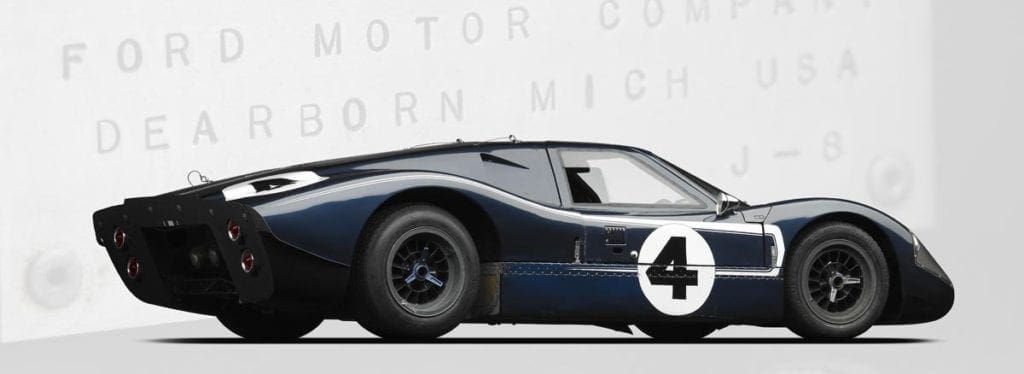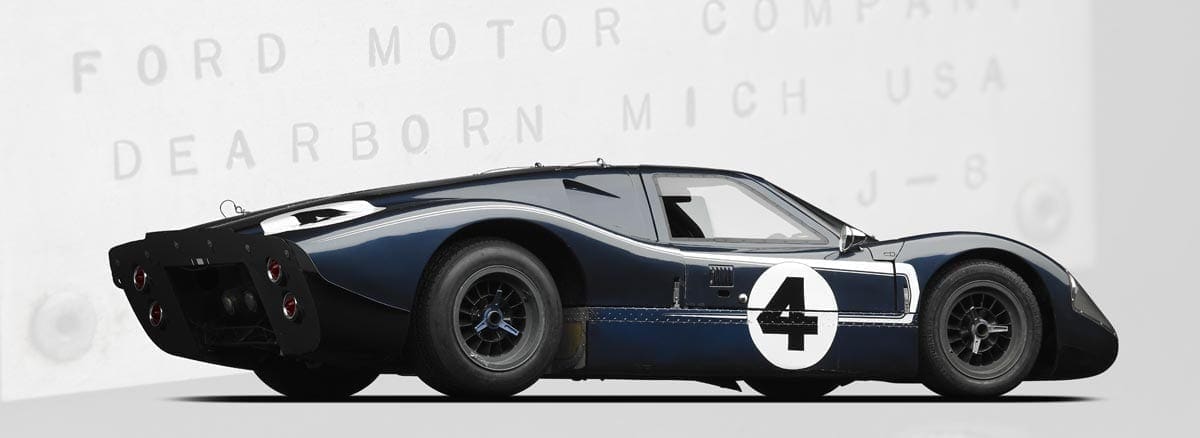Our car ran at Le Mans in 1967, the only race in its competition history, and then outlawed. This car is in unrestored, original, as-raced condition.
THESE CARS
The Mark IV was the ultimate evolution of the GT40 series and was replete with a variety of outstanding technological features. To discuss the engineering innovations Ford’s desire for victory and would be the subject of several chapters. Ford’s desire to make the car completely in the United States gave their newly formed racing satellite, Kar Kraft, a free hand to create such innovative features as a honeycombed aluminum chassis that was substantially lighter but virtually equal in strength to the steel version.
They added modifications the streamlined body shell and the 427 Ford engine was beefed up to give an optimal output. A special transaxle with its own cooling system carried power to the rear wheels. I refer one to the excellent historical analysis of Ronnie Spain’s “GT 40: An Individual History and Race Record” for a detailed description.
OUR CAR
Ford prepared 4 Mark IV cars to race at Le Mans, and the racing history of the Mark IV is really aall about that one 1967 Le Mans race, although one car won Sebring that same year. They assigned our car, J8, to Lloyd Ruby and Denny Hulme. During the race they were progressing nicely and, in fact, set the Le Mans top speed record at over 224 mph, the record equaled by Mario Andretti before his accident in that race.
It is said while traveling down the Mulsanne Straight at these dramatic high speeds the turning point at the end of the Straight had been misjudged, resulting in the car landing deeply into the sand. Attempts to dig it out with the in car equipment provided proved fruitless and ultimately the car had to be abandoned and later recovered after the race. They returned the J8 to Holman and Moody. What to do with these cars remained questionable. Apparently Ford planned to use some of them as show cars but not all. The alleged 1967 Le Mans winner, J6 driven by Dan Gurney and A. J. Foyt, was kept by the company and ultimately displayed in the Ford museum.
They donated J8 to the Harrah Automobile Collection on February 26, 1968. Some paint work was apparentley added to the front because the configuration of the letter “4” appears different than when raced. The rest of the car was probably not painted since there are various stress cracks throughout the body as would show up during the flexing of racing. It remained in the Harrah collection until September 27, 1985 when it was auctioned off by the Holiday Inn Corporation in the final lot of the day.
I had planned to attend this auction, but it was just impossible for me to get away from my clinical responsibilities. I learned, however, that George Stauffer purchased the car. I flew to Wisconsin to see him, having found out its availability. We struck a deal. At the time he had another car that was built-up from an unused J chassis in mint condition, whereas J8 looked somewhat tatty with its stress cracks and aged paint. I’m not sure whether George understood why I was only interested in the J8 but after some discussion I realized that this was the car for me.
Subsequently, we have done little to it. It was always in excellent running condition. Everything about her appears untouched. With these GT-40’s are we ever sure whether the actual racing engine is still in the car but there is no record of engine work being done prior to going to Harrah’s. It showed at the 100th anniversary of Ford at Laguna Seca and it has given us much pleasure since its purchase.

The GT40 had been an Anglo-American proposition from the start, with roots in Eric Broadley’s lovely little Lola Mark 6, but the Mark IV was to be a star-spangled affair, meant to erase all doubt that American know-how was superior to Italian 12-cylinder prancy-horsey voodoo—that it wasn’t the luck of the limeys that had spurred the Yanks on to victory the previous year.
Car and Driver

















